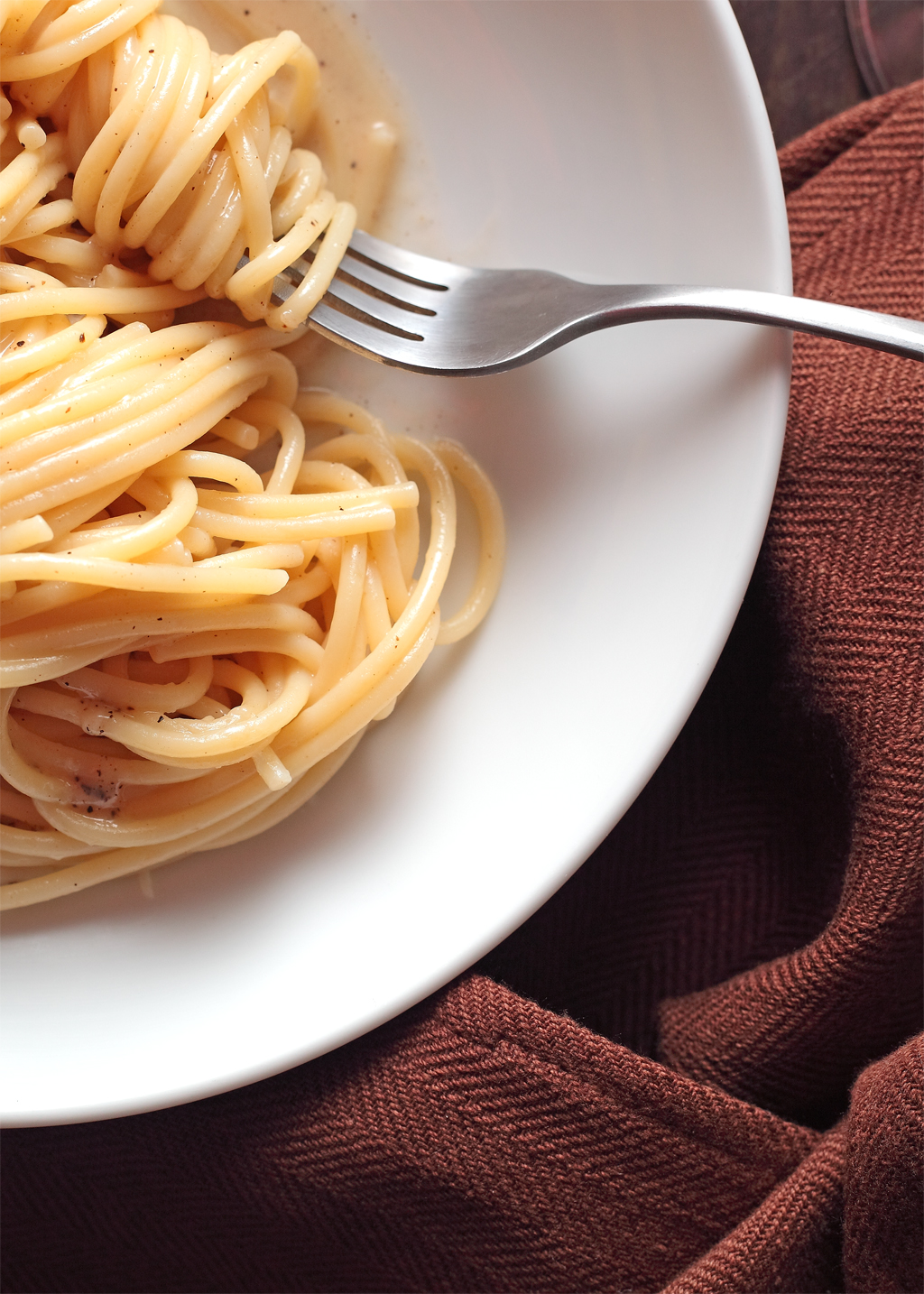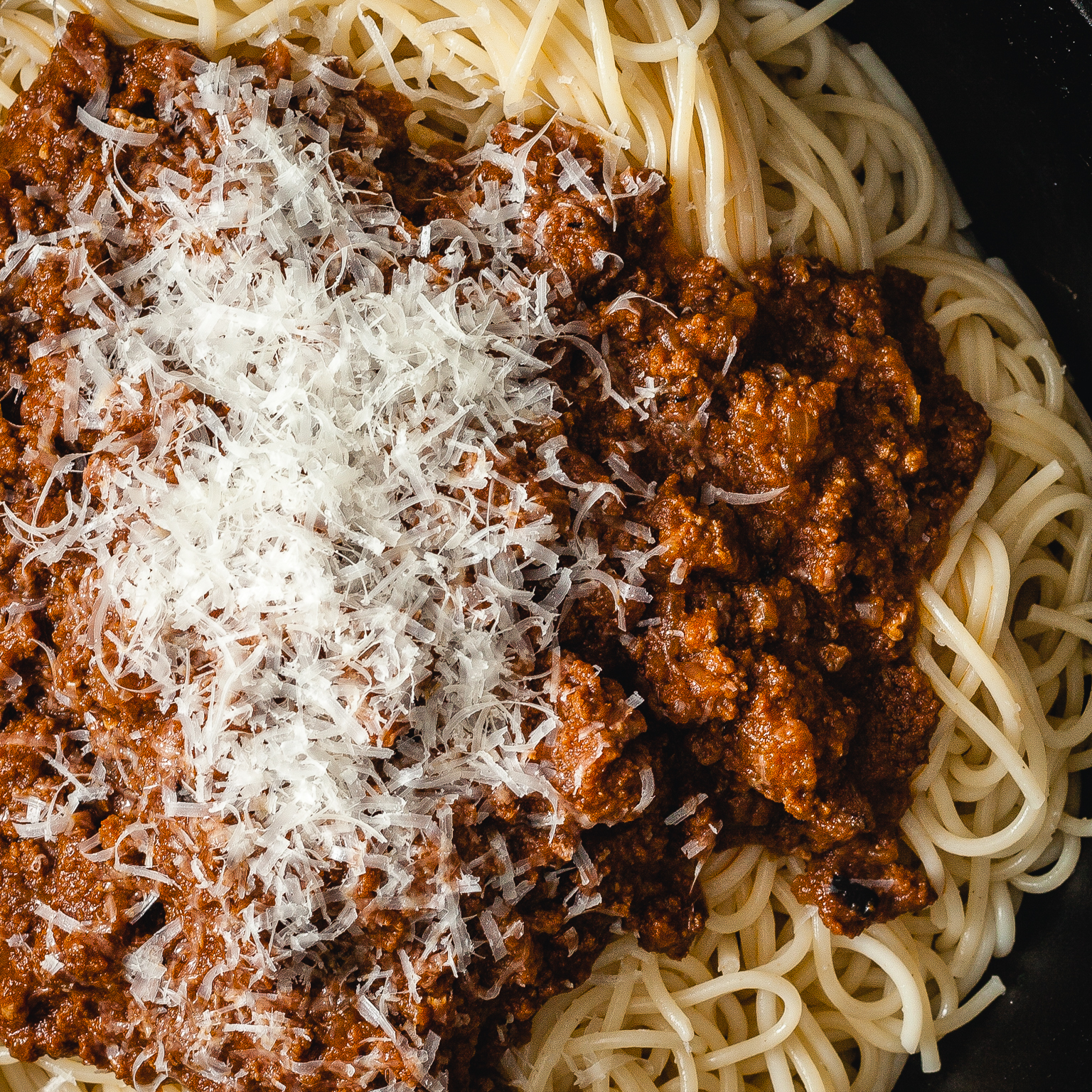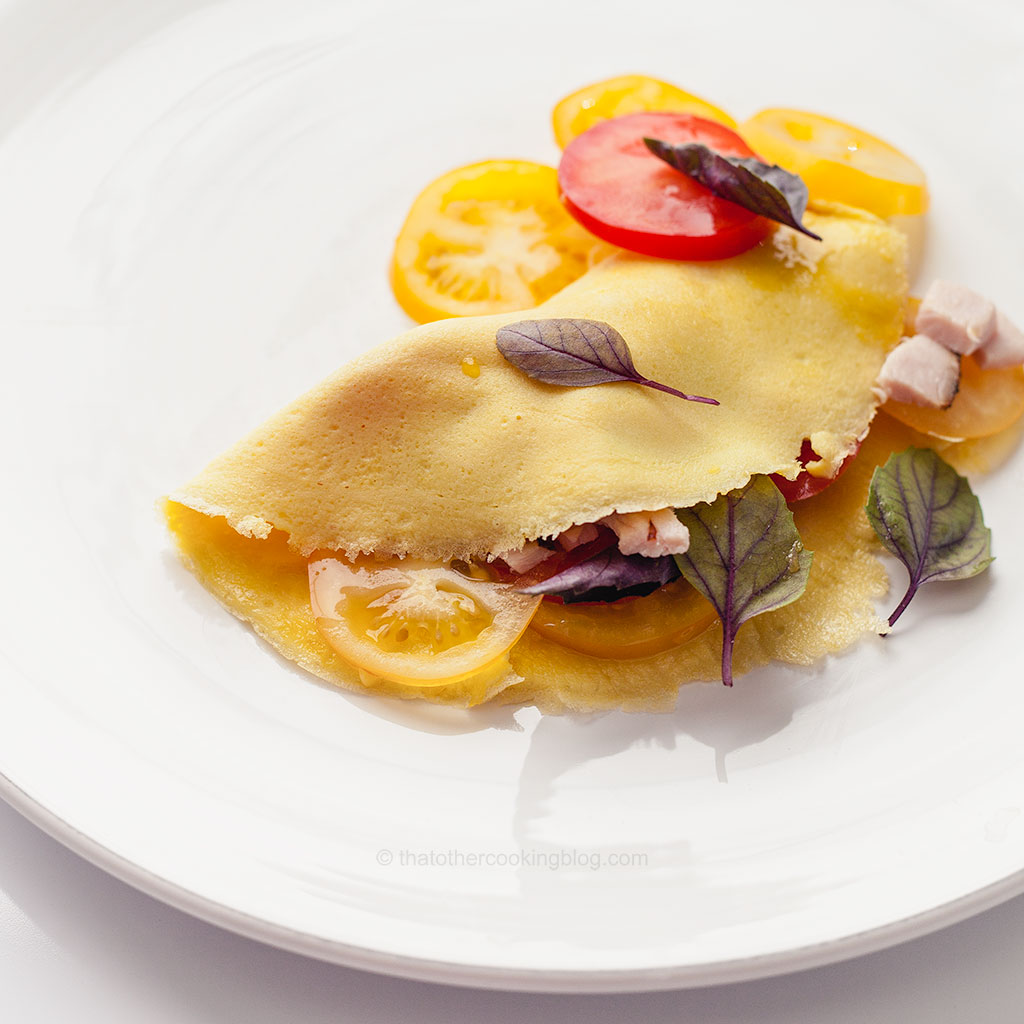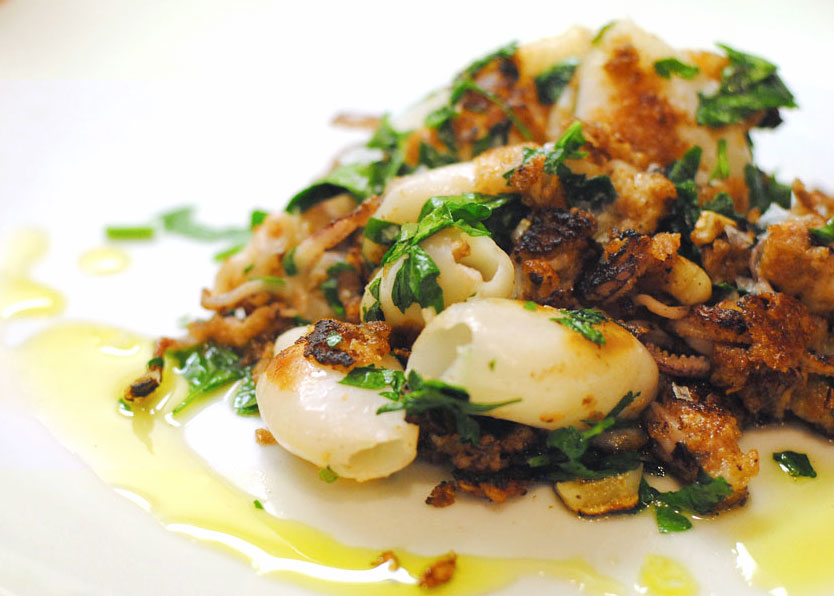Summer is slowly slipping away. It has been about a month since I last posted. I’ve in town but I’ve been away from my blog. I haven’t for once stopped thinking about it though, but a break was in the schedule, my mom and aunt came to visit me. I wish I could have continued blogging but it takes up so much time, at least it does in my case, all that cooking, taking pictures, editing photos, charging flash batteries, writing and formatting each post. You get the picture. I’m happy to say that both my mom and aunt had some fun times here and it was great to see them. Although blogging stopped, cooking didn’t. We made many meals, lunches and dinners, it was really fun enjoying homemade food and spending family time. It was pretty great.

So finally back. Today’s post is about simplicity and one classic italian recipe that captures it extremely well . Some of the most popular comfort food combinations contain carbs and cheese. Exactly… but few can resist it. Some fear the combination, because it packs a mighty caloric punch, so continue at your own risk. Cacio e pepe is one of those wonderful pasta dishes , it takes about 10 minutes to make and requires only 3 ingredients. Pasta, pecorino romano cheese and black pepper.
Simple preparations usually go hand in hand with high quality ingredients. Well, that actually should apply to any preparation, but is more crucial when only a few ingredients are being used. Milling your own peppercorns is something that if you haven’t tried it, you should. Black pepper freshly ground is so fragrant and flavorful that once you experience it, you’ll notice the difference from the pre-ground pepper. Also try to use good cheese, true italian pecorino if possible, there are some of pecorino cheeses out there that are more processed, have more additives, if you can, try to avoid those a well.

As I’ve explained in the past, I like to cook pasta in a pan that is wide enough to hold the spaghetti whole and enough water to cover the noodles. I start the pasta in cold water, and then bring the water to a simmer, doesn’t really need to boil. Even in cold water, dry pasta ill hydrate in a few minutes, and the gelling (cooking) of the pasta requires temperatures below boiling point 90C or 194F. Make sure to move the noodles a bit and allow water to coat them evenly, they could stick together otherwise. This method of cooking pasta requires less water, and less time, and the cooking water contains a higher concentration of starch, hence more thickening power. In this particular cacio e pepe preparation, I skip adding salt to the water, pecorino romano cheese is very salty and doesn’t need any help.
While the pasta is cooking, grate plenty of cheese, about 60g per serving. You should probably grate more just in case you need to adjust consistency of the cheese sauce. Also, get your peppercorns ground, this is an ingredient that has to be adjusted to taste. You can add more pepper at the end before serving.


One thing I love about simple recipes like this is that it is a perfect opportunity for experimenting and trying a few things without too much extra work. I’ve already talked about cooking pasta, hydrating and gelling of the starches, etc.. making bread teaches anyone a lot about how flour water and heat interact. One small problem I run into when making cacio e pepe is in the melting of the cheese. You have to work fast, you need the noodles at the starchy water hot to melt the cheese, and most of the adjusting of the sauce happens on the plate which is a skill I have yet to develop. It isn’t easy. Plus I find that the cheese doesn’t entirely melt and I find gritty bits here and there which isn’t the end of the world, but having read about how to enhance the texture of cheese sauces by using sodium citrate on the modernist cuisine book, I thought it’d be fun to try it. I was extremely pleased with the result. I will go over the “traditional” (at least what I think is the traditional way) and the modified version of this dish using sodium citrate:
The traditional way:
Once the pasta is ready al dente, reserve about a cup of the starchy water. Strain the rest of the water. The pasta needs to be hot. Plate the pasta and immediately add cheese over it, you can add about a tablespoon of pasta water, and with the help of a fork, stir it all. The cheese will melt and a cheese sauce will be created. Adjust the consistency of the sauce by adding more cheese if too watery, or more water if too thick. Sprinkle pepper and serve. As easy as that.
A different approach:
This is a slightly more forgiving take on the same dish. I like to create the cheese sauce separately before mixing with the pasta. Allows for some more control adjusting the consistency of it and the texture. The addition of sodium citrate creates a velvety texture that is hard to beat. Sodium citrate is a salt extracted from citric acid. Citric acid is found in acidic fruit like lemons and limes. Its consumption is as safe as consuming table salt, specially in the 2% quantity required in this recipe. Sodium citrate will allow the pecorino romano cheese to melt beautifully, without separating (stays emulsified) or curdling even at high temperatures. The cheese sauce can then be mixed with the pasta before serving. The pasta doesn’t have to be as hot as in the previous preparation. The consistency can be adjusted before mixing the sauce with the pasta.
Ingredients (one serving):
60g grated pecorino romano cheese
20g starchy water
1.6g sodium citrate (2% of the total weight)
Method:
In a sauce pan, simmer the starchy water and add the sodium citrate, stirring for a couple of minutes until dissolved. Keep the pan over the stove and add the cheese. Stir constantly, the mixture might boil, but that’s ok, the sodium citrate will keep the sauce behaving, and it won’t curdle. If the sauce to thick, add a little more water. If too watery, you can cook off some of the water until you reach the desired consistency. You can add the pasta to the sauce pan and mix the cheese sauce with the spaghetti before serving. Serve and add pepper to taste.



This dish is so elegant and easy to make, not to mention wonderful to eat and full of flavor and richness, anyone interested in italian cuisine and cooking should have it in their repertoire. Until next time fellow food enthusiasts! I’ll be working on some new recipes and ideas so stay tuned and thanks for visiting!
Wanna get more sous-vide cooking guides and cool cooking how-to’s in your mailbox? You know what needs to be done!
We never spam. You should only be getting updates when new content is posted on the site. We also respect your privacy. We don’t share your email address with anyone and you can unsubscribe anytime!





17 comments
You should work as food stylist … your photos is just so amazing. Not a fan of past without a rich sauce, but your photos here could convert me. *smile
🙂 thank you! you’re too nice. This pasta can be rich, I agree, but it can be served in smaller portions and followed but an entree that is lighter but more substantial hahah, I wouldn’t eat this pasta dish too often thats for sure 🙂
Never have used sodium citrate. Wondering what that would be like. Not even sure where I would find some.
Beautiful photos.
Thanks Janet! have you looked for it online? I agree, it isn’t common in home cooking, but pretty common in the food industry. It has a slight salty sour taste to it, but shouldn’t be noticeable if used in small quantities like in this recipe for example.
Well, you’ve taught me something new. I’ve been in the biz for almost thirty years and I can’t recall someone using it, but, I haven’t worked everywhere, I just feel like I have. 😉 Thank you!
I’m glad I did, you’re welcome!
Beautiful. I’m going to start doing my pasta like that too. Is that a cast-iron pan you’re using??
Am also going to try sodium citrate. Have been thinking about it for a while to get a nice sloppy, not gloopy chili con queso, but after reading this, there are a lot of other things that could benefit from it. Thanks, Paul!
that pan is a hard anodized one, not cast iron. It looks black like that because it has been through war many times 🙂 Glad to hear you want to experiment with sodium citrate. It’s super fun!
Such a simple dish but oh such an amazing flavour packed one. Have never used sodium citrate to make this, so am intrigued!
yeah, give it a try if you find it! Im sure it is available there as well.
“2% of the total weight”… du beziehst das auf Käse UND “starchy water”, andere Beiträge beziehen den Natriumcitrat-Anteil prozentual NUR auf die Käsemenge.
Was stimmt denn nun?
2% of 80g is 1.6g
80g comes from adding the cheese and the starchy water. Go with this. Thank you! Hope I understood your question since it’s in german I believe 🙂
Thanks Paul, you are right, the amount of natriumcitrate is related to the sum of cheese AND water, makes sense.
Yes, my question was in german, sorry.
The name of “Anonymous” is Klaus, sorry once again, shame on me.
Tomorrow I will try Natriumcitrate the first time, with 125 g Gorgonzola, 85 g of water and 4 g of Natriumcitrate and spaghetti.
Nice to meet you, Klaus! I have google translator on my side so no worries if you need to leave comments in german! 🙂 Let me know how your pasta turned out!
Well, this actually wasn’t the real challenge I was looking for since Gorgonzola picante perfectly melts by itself in hot sweet cream – natriumcitrate isn’t really necessary 🙁
But I will try it with cacio e pepe, this is really a hard challenge.
So far 80% have gone wrong, but not this time with natriumcitrate 🙂
My understanding is that not all cheeses melt. Of course, I haven’t tried every cheese out there but the cheese I like mostly melt. I’m glad your test worked out well! 🙂